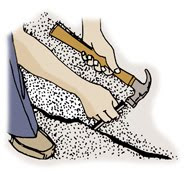Interlocking steel sheetpiling can be used to advantage:
- when excavating into water-bearing soils.
- when excavating into contaminated soils.
- when sheeting is to be removed after backfilling is complete
- when sheeting is to remain permanently exposed.
Careful consideration of the method of sheetpile installation is necessary.
Vibratory hammers are most commonly used. However, reconsolidation of vibrated soils can cause settlements adjacent to the sheetpile installation. Damaging vibrations can travel through soil to affect buildings and utility structures, sometimes with disastrous results. Sheetpiles can be advanced using impact pile driving hammers which shear the soil, instead of vibrate the soil, causing less damage to adjacent structures.
| Sheet pile walls are constructed by driving prefabricated sections into the ground. Soil conditions may allow for the sections to be vibrated into ground instead of it being hammer driven. The full wall is formed by connecting the joints of adjacent sheet pile sections in sequential installation. Sheet pile walls provide structural resistance by utilizing the full section. Steel sheet piles are most commonly used in deep excavations, although reinforced concrete sheet piles have also being used successfully. Steel sheet piling is the most common because of several advantages over other materials: 1. Provides high resistance to driving stresses. 2. Light weight 3. Can be reused on several projects. 4. Long service life above or below water with modest protection. 5. Easy to adapt the pile length by either welding or bolting 6. Joints are less apt to deform during driving. Sheet pile walls are constructed by: 1. Laying out a sequence of sheet pile sections, and ensuring that sheet piles will interlock. 2. Driving (or vibrating) the individual sheet piles to the desired depth. 3. Driving the second sheet pile with the interlocks between the first sheet pile and second "locked" 4. Repeating steps 2 & 3 until the wall perimeter is completed 5. Use connector elements when more complex shapes are used. Sheet pile wall disadvantages are: 1. Sections can rarely be used as part of the permanent structure. 2. Installation of sheet piles is difficult in soils with boulders or cobbles. In such cases, the desired wall depths may not be reached. 3. Excavation shapes are dictated by the sheet pile section and interlocking elements. 4. Sheet pile driving may cause neighborhood distrurbace 5. Settlements in adjacent properties may take place due to installation vibrations |










No comments:
Post a Comment